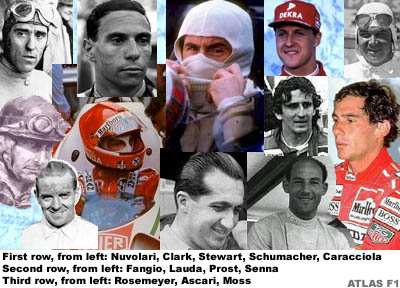 |
|
| The Best of the Best | |
| by Barry Kalb, Hong Kong | |
|
Atlas F1 is proud to present a series of features on the all-time greatest drivers of Formula One, written by veteran journalist Barry Kalb.
This week's feature: Conclusion and Statistical Tables Is there one greatest driver of all times? Alfred Neubauer said Caracciola was the best. Enzo Ferrari named Nuvolari and Moss, Moss says it was Fangio, Niki Lauda and not a few journalists have said it was Senna. But such statements are meaningless. What possible comparison could be made of drivers from different eras, in cars employing different technologies, offering vastly different levels of handling characteristics, over a period of 60 or 70 years? The answer, of course, is none. There is no way to make a valid comparison between, say, Nuvolari and Clark, between Moss and Senna, or even between such contemporaries as Moss and Fangio, Senna and Schumacher. Was Moss, who was rising as Fangio's career was fading, ultimately as good as Fangio? Would Clark, whose career began as Moss's ended (and who was already beginning to worry Moss in 1961), have begun beating Moss in one-to-one battles? Would Schumacher, whose career was just starting as Senna's ended (and was already beginning to worry Senna), have beaten the Brazilian in equal cars? There is this to consider. The driver one happens to follow, the driver one happens to see in an actual race, is the driver likely to make the greatest impact on a spectator. Senna, whose career coincided with the advent of live, world-wide broadcasting of Formula One, who raced in Formula One for ten years, who became one of the best-known sports figures in the world - who died so tragically and so spectacularly on live television - is the name many people now alive identify with. In fact, Senna and Schumacher are the only great drivers a very large percentage of today's Formula One fans ever saw in a race. Those who saw Jimmy Clark race, or Stirling Moss, or Juan Fangio, tend to be more measured in their assessment of "the greatest."
But that is the stuff of fantasy.
* * *
If nothing else, statistics tell the story. In the matter of wins per start, poles per start, points per start, podium finishes per start, some men stand at the pinnacle of their sport. They are, to a large extent, The Best of the Best. Here are their achievements, in the numbers: TABLE 1 - Driver statistics, 1950 to Brazil 1999. TABLE 2,3,4 - Drivers with 20 or more wins; Drivers with 10 or more wins, or world champion; Other notable drivers. TABLE 5 - Ranking of top drivers in major categories. |
| Barry Kalb | © 1999 Atlas Formula One Journal. |
| Send comments to: bkalb@asiaonline.net | Terms & Conditions |
Barry Kalb is a veteran journalist of 20 years' experience (the Washington Star, CBS News, Time Magazine) and a motor racing fan - especially Formula One - for almost 40 years. He currently resides in Hong Kong. | |
